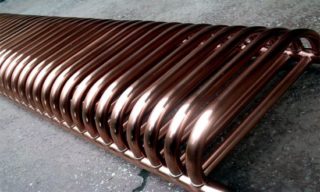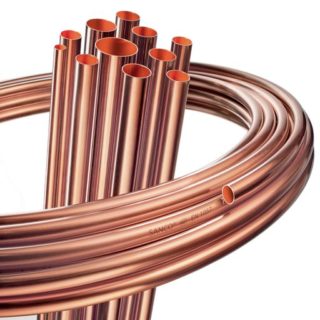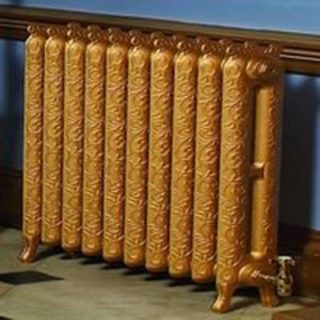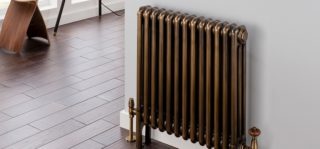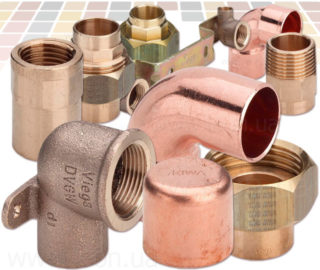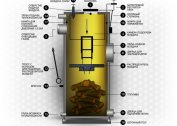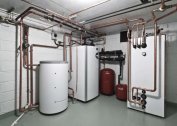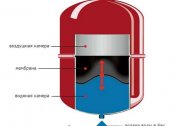With the onset of cold weather, the heating system maintains a comfortable temperature in the house. Its effectiveness largely depends on the choice of radiators. When choosing devices, their heat transfer, design and durability are evaluated. Copper radiators are distinguished by excellent performance, but they are rarely used for heating installation. Low popularity is associated with the high cost of equipment. Otherwise, copper batteries outperform low-cost aluminum or steel counterparts.
Design features of copper radiators
The use of copper with a minimum amount of impurity allows to reveal all the advantages of the material. Non-ferrous metal is not afraid of corrosion, it is durable and soft at the same time. The attractive appearance of copper batteries does not require painting. Heating devices are made in various options. Their design features affect the level of heat transfer.
Radiators are made of copper tubes of various diameters. In order to increase the area of heat transfer, in-line plates of non-ferrous metal are welded to them. Tubular elements are horizontal and vertical directions. Devices consist of several sections. The number of pipes and plates depends on the model. There are options on the market with a protective cover made of metal or wood. Decorative cladding is selected to the interior of the owners of the house.
Advantages and disadvantages
Despite the high cost, copper batteries are installed in private homes and apartments. The popularity of devices is justified by the advantages of the material:
- high level of heat transfer;
- continuous operation;
- resistance to pressure up to 16 atmospheres;
- no deposits form on the inside of the pipes;
- coolant temperature up to 150 ° C;
- resistance to impurities in the coolant.
Soft metal does not leak with a brief increase in pressure. Copper batteries are lightweight and versatile in use.
Disadvantages:
- Devices are sensitive to the effects of abrasive particles. Their presence in the fluid stream accelerates the wear of products.
- At installation it is impossible to use fittings from ferrous metals. This leads to the oxidation of copper.
- The high cost of copper heating radiators for most buyers is a major drawback.
Non-ferrous metal is not afraid of corrosion resulting from contact with water and air. But copper products are susceptible to oxidation due to a chemical reaction to contact with aluminum or steel.
Principle of operation
Radiators - part of the heating system responsible for the transfer of heat. The fluid circulating in the circuit is heated in the boiler. Through the pipeline, it enters the batteries. High water temperature contributes to the heating of the metal. Copper has a high thermal conductivity, the indicator exceeds the characteristics of steel several times. The work of radiators is based on physical processes:
- Thermal conductivity - the transfer of energy from heated bodies to colder ones. Pure copper, which is used in the manufacture of batteries, has an indicator of 401 W / (m * K). This is one of the highest values among metals.
- Thermal radiation - hot metal propagates infrared waves.
- Convection - heat transfer by air flow. Cold air masses pass through the radiator, their temperature rises. The heated stream rises to the ceiling.Heavy cold air takes its place, making the process continuous.
The copper radiator is highly efficient. Its characteristics provide a rapid increase in temperature in the room.
Which battery to choose
The cost of radiators is not the last criterion when buying a device. Aluminum batteries are sensitive to the composition of the coolant, have a small working pressure, and are sensitive to water hammer. They are not recommended for installation in apartments with central heating. Aluminum appliances will be the best budget solution for a private home. Copper batteries lack these shortcomings. They are effective, resistant to aggressive effects.
Choosing between copper and aluminum cooling radiators, consider related factors. The non-ferrous metal structure has a small diameter and is more susceptible to corrosion. Aluminum tubes with a cross section are 2 times less likely to clog and last longer.
Installation methods for copper radiators
To make efficient heating and not spoil the interior, choose one of two ways to install batteries.
Wall mount
Brackets are used for wall mounting the batteries. They are fixed on the supporting structure and serve as the basis for the installation of heating appliances. The best option for placing radiators is a place under the window. According to building codes, the length of the device should be 50-75% of the size of the window structure. The rules require installing batteries at a distance of 60-100 mm from the floor, and 30-50 mm from the wall.
On legs
Floor placement has its advantages: eliminates the load on the wall, simplifies installation. Such models are popular in interiors with panoramic windows. They are installed in cottages, country houses, offices. The minus of the battery on the legs is the limited connection, only floor piping is suitable.
Equipment for the installation of copper radiators
One of the factors of safe operation of the heating system is the installation of shutoff valves.
Mayevsky crane
For normal operation of the water heating system, the batteries must be equipped with a Mayevsky tap. This device is used to discharge air accumulated in the pipes. It is mounted on top of the battery. The shut-off valve is opened after starting the system in order to bleed air that has got into it and to prevent the formation of plugs. After turning the valve one revolution, a hiss appears, characteristic of the air outlet. The tap is kept open until a trickle of water appears.
Stop valves
Faucets and valves are needed to adjust the amount of coolant in the batteries, as well as forced drainage. Shut-off valves allow shutting off the water flow in the event of a radiator breakdown. It is made of brass, the connection with the pipe is threaded. Thermostatic expansion valves, depending on the model, require manual correction or are automatic.
Bypass
A bypass pipe is installed between the input and output lines. Its diameter is less than the cross section of the connected pipes. A jumper allows the coolant to bypass the battery. The element is characteristic of a single pipe heating system. A crane can be installed on the bypass, then the movement of water is controlled.
When installing copper heating batteries, do not use ferrous metal fittings. To avoid a chemical reaction, all fittings must be made of brass.
A variety of copper radiators
When choosing a suitable radiator option, it is worth evaluating their appearance and technical characteristics. The main one is the heat transfer of the device, it shows how much space the device can heat. Batteries can be installed in rooms with high humidity.Different models of heated towel rails are available for bathrooms. In stores, there are radiators made of copper of domestic and foreign production. Products from China are not recommended, they are cheaper due to the use of thin sheets of copper. Radiators are limited in life. An alternative to buying an expensive radiator will be a bimetal model. The coolant in them is made of copper, and the outer panels of aluminum.
Among the variety of heating devices, copper radiators stand out with a minimum of shortcomings. They are universal in application and have high heat dissipation. Significant cost is the only minus of appliances.
